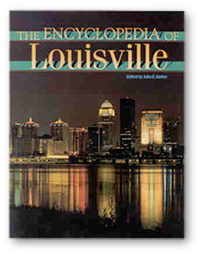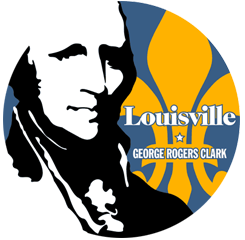Why John Kleber hasn’t seen the sunshine in four years
The story of John Kleber’s journey to compile Louisville’s definitive historical reference book
The brand new Encyclopedia of Louisville, a hefty, hard cover volume, contains contributions from a staggering roster of over 500 writers. The book is comprised of 1,800 separate entries dealing in broad categories – people, places, things, events – ranging in categories from art and architecture to communications to politics to women. Forty-percent of the entries are biographical sketches of people. The complete story of Louisville comes together like a jigsaw puzzle whose pieces are spread across 1,100 pages, then augmented with 350 photos, 60 maps, and an alphabetical index.
The Encyclopedia of Louisville is packed with everything you’d expect to find in a book of this sort. Obviously included are histories of landmarks and events like Corn Island, Muhammad Ali, Fort Nelson, the construction of City Hall, and the Chenoweth Massacre. More general information is added in the form of entries with titles such as “Epidemics,” “Iron Foundries,” “Painting,” and “Brick Industry.” The balance of the blanks are filled in with essays on every imaginable topic relevant to the development of the city. “Film-Making,” “Cato Watts,” “Douglass Hills,” “Brown-Gordon Murders,” “Rev. A.D. Williams King,” “Kaden Tower.”
Special efforts were made to include topics relating to women, minorities, and other cities of Jefferson County. Fifteen consulting editors were employed to manage topics that were of a somewhat subjective nature – art, politics, ethnology, music, literature, et cetera.
The Book

The true magnitude and detail involved must be witnesses to truly be appreciated. It’s all too easy to sit down with the intention of looking up a specific fact, and then find yourself an hour later reading about something else entirely, having been lured in by other stories while flipping the pages.
One intriguing segment investigates the origins of people referring to the city as “Lou-a-vul,” a trend that is documented to have begun as early as the late 19th Century. In the same regard, another piece explores the first uses of the word “Kentuckiana” by the local media – as early as the 1940s.
The namesakes of Louisville area locations are among the most interesting – yet unexpected – bits of information the reader stumbles upon. George Hikes (Point). John Baxter (Avenue). James Grinstead (Drive). Dr. Elisha D. Standiford (Field). William Fontaine (Ferry Park). William McAlpine (Locks and Dam). Henry Watterson (Expressway). John Buechel. Dominic Ehrler (-‘s Dairy). Robert, John, Alexander, and James Breckinridge (whose Lane has since become misspelled as “Breckenridge”).
The Journey
As the public begins to discover the book and the widespread enthusiasm for the project is reaching its peak, the intensity is winding down for Dr. John E. Kleber. As the book’s editor, the Louisville native and his staff of experts from assorted fields of Louisville history embarked on the four-year journey to create this book in 1996.
Now one of Kentucky’s most respected historians, John Kleber was a member of the third graduating class of Trinity High School in 1959. Four years later he earned a history BA at Bellarmine College, graduating summa cum laude. By 1969, Kleber had earned his Master’s degree and PhD from the University of Kentucky. At Morehead State University, he became associate professor of history, director of the Academic Honors Program, and dean of the Caudill College of Humanities.
Having previously edited the equally gargantuan Kentucky Encyclopedia – a project that consumed his life from 1988 to 1991 – Kleber was an obvious choice for editor of The Encyclopedia of Louisville. In 1996, as he was retiring from Morehead, Kleber was invited to coordinate and edit the The Encyclopedia of Louisville.
Kleber accepted the offer, returned to Louisville, and set up shop in an office on the University of Louisville’s Belknap Campus. This room with three computers and a tree-lined view of the downtown skyline provided the perfect setting for the project.
Kleber is quick to clarify that he is not the author of the Encyclopedia. “This is a community effort. I simply coordinated it. With five hundred writers and fifteen other editors, this is something community did for itself and gives to itself.” He imagines that the total personality of Louisville comes across through its pages. “The strengths and weaknesses of the writers and editors reflect the strengths and weaknesses of Louisville.”
Three associate editors assisted Kleber in assembling and fine-tuning the Encyclopedia: George Yater (author of 1987’s Two Hundred Years at the Falls of the Ohio: A History of Louisville and Jefferson County), Bellarmine University’s Clyde Crews (author of Spirited City: Essays in Louisville History), and state historian laureate Thomas Clark.
The Project
“Several cities around country have done urban encyclopedias,” Kleber recounts. “The first was Cleveland. The closest to Louisville is Indianapolis.” The early motivation for Louisville’s version “…came from the University Press of Kentucky and the Thomas D. Clark Foundation. Because of success of the Kentucky Encyclopedia, and because other cities had done it, they thought Louisville could use one as well.” Cities such as Memphis have been trying for years to start such a project, but either the funding or community cooperation hasn’t come together. Kleber believes the simple fact that The Encyclopedia of Louisville exists is a testament to the city’s uniqueness.
“Accuracy was our greatest concern,” Kleber explains, “but it’s inevitable that there are going to be mistakes in the book. We selected writers who knew their material. We had a fact checker [for each piece] and then it was read by the editor in the field. Everything was then read by Clyde Crews, George Yater and Mary Jean Kinsman, the managing editor, who all flagged things they caught. Some of the topics were so historically specific that it comes down to the fact that only the person who wrote [certain pieces] knows the truth. There are also occasions when records have been passed down in an erroneous manner.” Kleber credits the Filson Club of Louisville with being responsible for much of the city’s records having been preserved.
As for Kleber’s hopes for how the book will be received, he’s delighted that the Mayor’s Office is planning on giving them as gifts to visitors and dignitaries. “It pulls together a lot of information about the metropolitan area that’s hard to find, and presents it in an easy manner as one reference source. I would hope that it would be used by the people of Louisville and give them a greater appreciation and understanding of their city. I really want to see it in the hands of students. My hope is that the things [people learn] will lead to raising more questions and more future research.”
©2000 Louisville Magazine, Inc / louisville.com / by Scott Ritcher
